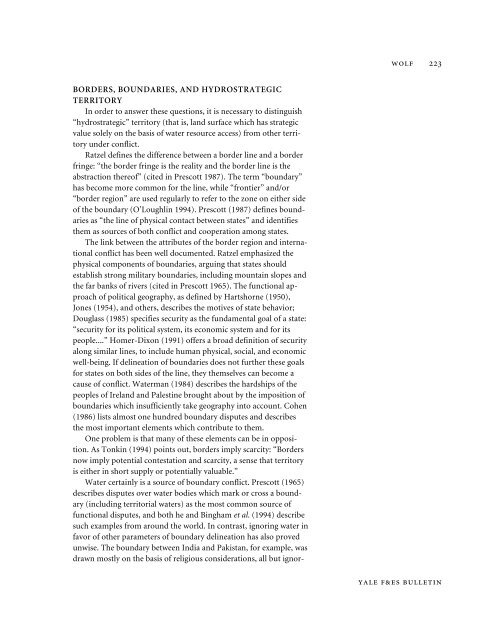Hydrostrategic Decisionmaking and the Arab ... - Yale University
Hydrostrategic Decisionmaking and the Arab ... - Yale University
Hydrostrategic Decisionmaking and the Arab ... - Yale University
You also want an ePaper? Increase the reach of your titles
YUMPU automatically turns print PDFs into web optimized ePapers that Google loves.
WOLF 223BORDERS, BOUNDARIES, AND HYDROSTRATEGICTERRITORYIn order to answer <strong>the</strong>se questions, it is necessary to distinguish“hydrostrategic” territory (that is, l<strong>and</strong> surface which has strategicvalue solely on <strong>the</strong> basis of water resource access) from o<strong>the</strong>r territoryunder conflict.Ratzel defines <strong>the</strong> difference between a border line <strong>and</strong> a borderfringe: “<strong>the</strong> border fringe is <strong>the</strong> reality <strong>and</strong> <strong>the</strong> border line is <strong>the</strong>abstraction <strong>the</strong>reof” (cited in Prescott 1987). The term “boundary”has become more common for <strong>the</strong> line, while “frontier” <strong>and</strong>/or“border region” are used regularly to refer to <strong>the</strong> zone on ei<strong>the</strong>r sideof <strong>the</strong> boundary (O’Loughlin 1994). Prescott (1987) defines boundariesas “<strong>the</strong> line of physical contact between states” <strong>and</strong> identifies<strong>the</strong>m as sources of both conflict <strong>and</strong> cooperation among states.The link between <strong>the</strong> attributes of <strong>the</strong> border region <strong>and</strong> internationalconflict has been well documented. Ratzel emphasized <strong>the</strong>physical components of boundaries, arguing that states shouldestablish strong military boundaries, including mountain slopes <strong>and</strong><strong>the</strong> far banks of rivers (cited in Prescott 1965). The functional approachof political geography, as defined by Hartshorne (1950),Jones (1954), <strong>and</strong> o<strong>the</strong>rs, describes <strong>the</strong> motives of state behavior;Douglass (1985) specifies security as <strong>the</strong> fundamental goal of a state:“security for its political system, its economic system <strong>and</strong> for itspeople....” Homer-Dixon (1991) offers a broad definition of securityalong similar lines, to include human physical, social, <strong>and</strong> economicwell-being. If delineation of boundaries does not fur<strong>the</strong>r <strong>the</strong>se goalsfor states on both sides of <strong>the</strong> line, <strong>the</strong>y <strong>the</strong>mselves can become acause of conflict. Waterman (1984) describes <strong>the</strong> hardships of <strong>the</strong>peoples of Irel<strong>and</strong> <strong>and</strong> Palestine brought about by <strong>the</strong> imposition ofboundaries which insufficiently take geography into account. Cohen(1986) lists almost one hundred boundary disputes <strong>and</strong> describes<strong>the</strong> most important elements which contribute to <strong>the</strong>m.One problem is that many of <strong>the</strong>se elements can be in opposition.As Tonkin (1994) points out, borders imply scarcity: “Bordersnow imply potential contestation <strong>and</strong> scarcity, a sense that territoryis ei<strong>the</strong>r in short supply or potentially valuable.”Water certainly is a source of boundary conflict. Prescott (1965)describes disputes over water bodies which mark or cross a boundary(including territorial waters) as <strong>the</strong> most common source offunctional disputes, <strong>and</strong> both he <strong>and</strong> Bingham et al. (1994) describesuch examples from around <strong>the</strong> world. In contrast, ignoring water infavor of o<strong>the</strong>r parameters of boundary delineation has also provedunwise. The boundary between India <strong>and</strong> Pakistan, for example, wasdrawn mostly on <strong>the</strong> basis of religious considerations, all but ignor-YALE F&ES BULLETIN
















